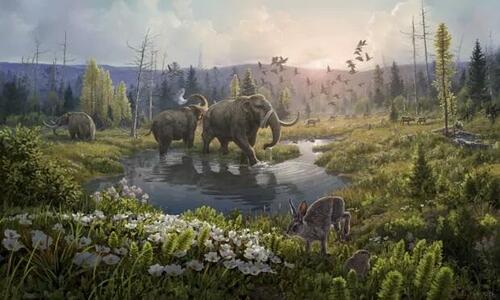Courtesy of ZeroHedge
Two-million-year old DNA from northern Greenland has pushed back the genetic record by 1 million years to a time when the Arctic region was 50-65 degrees warmer, and home to abundant wildlife – including mastodons, lemmings and geese, The Guardian reports.

According to researchers from the University of Cambridge and University of Coppenhagen, the northern peninsula of Greenland – which is now a polar desert – once contained boreal forests of popular and birch trees that were teeming with wildlife.
“A new chapter spanning 1m extra years of history has finally been opened and for the first time we can look directly at the DNA of a past ecosystem that far back in time,” said the researchers, Prof. Eske Willerslev, adding “DNA can degrade quickly but we’ve shown that under the right circumstances, we can now go back further in time than anyone could have dared imagine.”
Willerslev added that similar techniques could someday be used to uncover insights into the first humans and their ancestors.
Willerslev and colleagues worked for 16 years on the project, which resulted in the DNA of 41 samples found hidden in clay and quartz being sequenced and identified. The ancient DNA samples were found buried deep in the Kap København Formation, a sediment deposit almost 100 metres thick that built up over 20,000 years. The sediment, tucked in the mouth of a fjord in the Arctic Ocean in Greenland’s northernmost point, was eventually preserved in ice or permafrost and lay undisturbed by humans for 2m years.
Extracting and analysing the DNA was a painstaking process that involved piecing together tiny fragments of genetic material that first needed to be detached from clay and quartz sediment. It was only the advent of a new generation of DNA sequencing techniques that allowed the scientists to identify and piece together extremely small and damaged fragments of DNA, through referencing extensive libraries of DNA collected from present-day animals, plants and microorganisms. -The Guardian
Once they pieced together the fragments, a picture emerged of forests teeming with reindeer, rabbits, lemmings and mastodons – the latter of which have previously only been found in North and Central America.
No carnivores were found, most likely because they were fewer in number, however the researchers speculated that there were likely ancient sabre-toothed tigers, wolves or bears.
“We don’t know what was there, but probably something that ate mastodons and reindeers,” said the authors, adding that it’s encouraging that these species have been able to thrive so far north in a region that would have still been cast into darkness for much of the winter due to its location.
“The data suggests that more species can evolve and adapt to wildly varying temperatures than previously thought,” said Dr Mikkel Pedersen, of the Lundbeck Foundation GeoGenetics Centre at the University of Copenhagen and co-first author.


